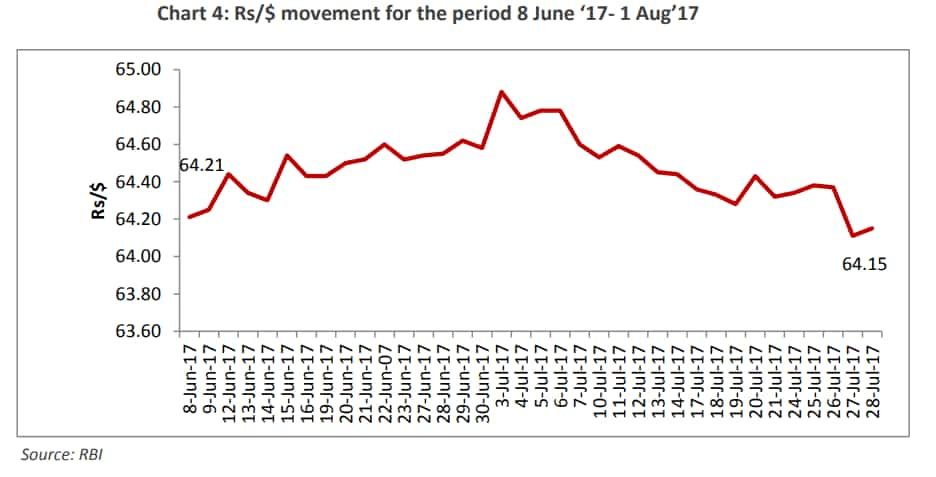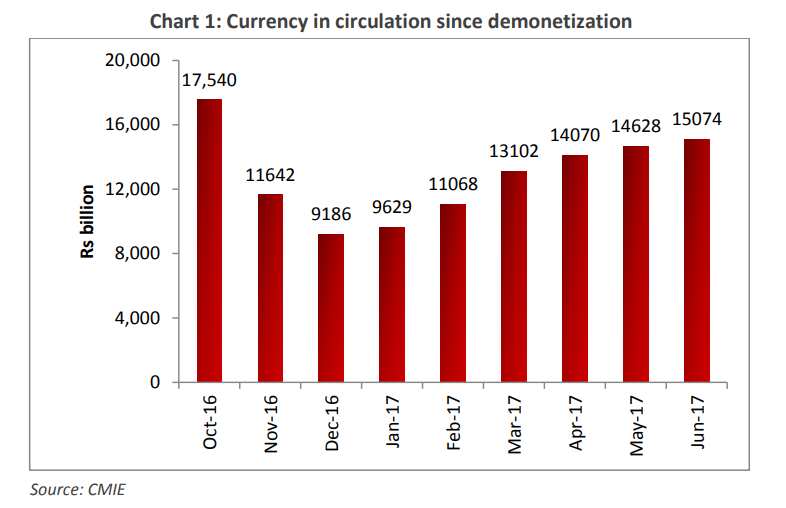10 things to know before RBI's August bi-monthly monetary policy
Policy repo rate stands at 6.25% presently. Markets are expecting a rate cut while few analysts believe it would be another status quo in this monetary policy review.

Key Highlights:
- RBI has maintained status quo in June Policy
- Policy repo rate stands at 6.25%
- Since last three policy, repo rate has been kept unchanged
Third bi-monthly monetary policy for the fiscal year 2017-18 (FY18) will be presented by the Reserve Bank of India (RBI) and Monetary Policy Committee (MPC) on Wednesday.
It will be the sixth monetary policy review by Urjit Patel RBI governor and the six-member Monetary Policy Committee (MPC).
Policy repo rate under the liquidity adjustment facility (LAF) currently stands at 6.25%.
Here's a list of factors that one needs to see before the policy:
Gross Domestic Product (GDP) Growth:
India's GDP growth declined from 8% in FY16 to 7.1% in FY17 as per provisional estimates on account of fall in mining and quarrying, construction and services.
source: tradingeconomics.com
Additionally the new change in the base year of macro-economic indicators like Index of Industrial Production (IIP) and WPI inflation was an impact for compilation of the GDP.
Consumer Price Index (CPI) Inflation:
At present, CPI inflation has resulted in to a historic low of 1.5% in the month of June 2017 as against 2.18% in May 2017 and 2.99% in April 2017. Decline was due to drop in food prices like cereals, egg, pulses, sugar, milk, spices and vegetables and also due to favorable base effect.
source: tradingeconomics.com
Care Ratings in its research report mentioned that inflation in non-food components still remain in the range of 5% with inflation in housing recording a growth of 4.70% and with implementation of 7th Pay Commission, inflation in housing index might further increase.
Wholesale Price Index (WPI) Inflation:
Just like CPI, another indicator of inflation WPI has reached to 0.9% - the lowest in 11 months, compared to 2.1% recorded in May 2017. Such was led by deflation in food and non-food articles – which were at low levels and also decline witnessed fuel and power prices.
source: tradingeconomics.com
As per Care, oil prices have increased by around 10% from the last monetary policy as a result of decline in U.S. crude inventories and recent decision of Saudi Arabia- the world’s largest oil exporter to cut back its exports.
Movement in 10-year Government-Securities (G-Secs):
10-year G-Secs yield has come down from 6.53% to 6.46% between June 08, 2017 – July 28, 2017. Care said, “Government securities have witnessed an increase in demand from both domestic and foreign investors where domestic demand has largely been driven by banks that are flushed with surplus liquidity post demonetization.”

A total of Rs 53,330 crore has been infused by foreign investors in Indian markets between June 2017 – July 2017 – among which debt market has Rs 44,552 crore and equity with Rs 8,778 crore inflows.
INR movement:
Indian Rupee continues to strengthen against benchmark US dollar since the start of the year 2017 on account of strong foreign inflows and improved investors sentiments on back of roll out of Goods and Services Tax (GST).

INR has moved from Rs 64.21 per dollar to Rs 64.15 per dollar during June 08 – July 28, 2017.
Bank deposit:
Bank deposits has seen contraction of 1% from April 2017 – July 2017 compared to the growth of 3% in the corresponding period of the previous year.

Bank credit growth:
Credit growth in the economy has also contracted by (-) 1.7% during April – July 2017 as against a gradual growth of 0.2% a year ago same period.
This was due to lack of pick-up in investments, high non-performing assets (NPAs) coming in the way of banks interest lending and increased capital requirements besides migration to debt market.
Money Supply:
From April – July 2017, money supply has been muted. It grew by just 0.3% during the period versus the growth of 3.4% in the similar period of the previous year. Interestingly this continues to be low despite India reaching to remonetisation level.
Currency-In-Circulation (CIC):
CIC has in the system stands at Rs 15,074 in the month of June 2017 – rising by around 29% since November 2016 when demonetisation took place. CIC has been consistently increasing over the months as RBI infused more cash in the system.

Liquidity Surplus:
RBI had conducted two Open market purchases in the month of July amounting to Rs 20,000 crore (Rs 200 billion) to absorb the excess liquidity in the market.
There is still excess liquidity in the system that can be illustrated through increase in reverse repo flows since demonetization. The o/s reverse stood at Rs 265,645 crores as on July 28, 2017.
Naresh Takkar, Managing Director and Group CEO, ICRA said “ We expect further OMO sales of Rs. 300-400 billion in multiple tranches, to supplement the absorption of surplus liquidity through other short term tools.”
Madan Sabnavis and Manisha Sachdeva, economists at Care Ratings said, "We expect RBI to maintain status quo in its interest rates in the upcoming RBI policy view as inflation potential is still uncertain due to implementation of GST, farm loan waivers and 7 th pay commission allowances."
The duo added, ''We expect RBI to initiate a rate cut in the month of October’17, once the picture becomes clearer and upside risks to inflation subside."
On the other hand, Takkar expects a 25 basis points repo rate cut in this policy meet due to favorable monsoon and record low inflation.
ALSO READ:
Get Latest Business News, Stock Market Updates and Videos; Check your tax outgo through Income Tax Calculator and save money through our Personal Finance coverage. Check Business Breaking News Live on Zee Business Twitter and Facebook. Subscribe on YouTube.
RECOMMENDED STORIES

IPL Auction 2025 Free Live Streaming: When and where to watch Indian Premier League 2025 mega auction live online, on TV, Mobile Apps, and Laptop?

SIP vs PPF: How much corpus you can build in 15 years by investing Rs 1.5 lakh per year? Understand through calculations

SBI Senior Citizen Latest FD Rates: What senior citizens can get on Rs 7 lakh, Rs 14 lakh, and Rs 21 lakh investments in Amrit Vrishti, 1-, 3-, and 5-year fixed deposits
01:01 PM IST








 RBI cancels licence of Vijayawada-based Durga Co-op Urban Bank
RBI cancels licence of Vijayawada-based Durga Co-op Urban Bank  Reserve Bank amends master direction on KYC
Reserve Bank amends master direction on KYC  Nearly 98% of Rs 2000 banknotes returned; Rs 6,970 crore worth notes still with public
Nearly 98% of Rs 2000 banknotes returned; Rs 6,970 crore worth notes still with public Rupee settles on flat note, rises 1 paisa to 84.07 against US dollar
Rupee settles on flat note, rises 1 paisa to 84.07 against US dollar  Retail inflation likely to average 4.5% in FY25: RBI Deputy Governor
Retail inflation likely to average 4.5% in FY25: RBI Deputy Governor